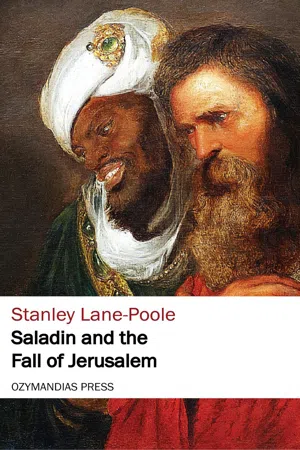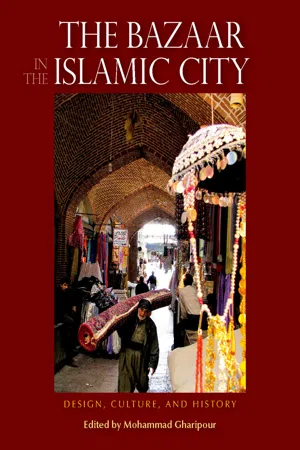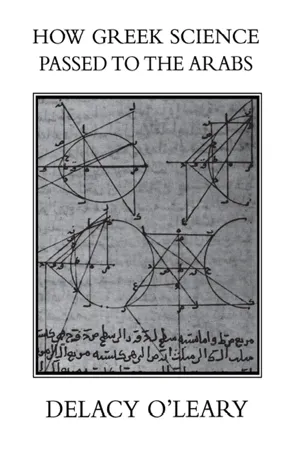History
Siege of Damascus
The Siege of Damascus was a military campaign that took place in 634-635 AD during the early Arab-Byzantine Wars. It was a pivotal battle between the Rashidun Caliphate and the Byzantine Empire, resulting in the capture of Damascus by the Muslim forces. The siege marked a significant turning point in the expansion of the Islamic empire into the Levant region.
Written by Perlego with AI-assistance
Related key terms
4 Key excerpts on "Siege of Damascus"
- eBook - ePub
- Philip Rousseau, Philip Rousseau(Authors)
- 2012(Publication Date)
- Wiley-Blackwell(Publisher)
Having gone through the Byzantine–Sasanian war (AD 602–28), which effectively bled both empires white, and having previously canceled its alliance with the Ghassanids, which led to disaffection among the Arabs of Syria, the empire was at its weakest in AD 633. It had not had the opportunity to rebuild the defenses of the region of southern Syria-Palestine, or to reforge the alliances with local, Christian Arab tribes that could have defeated the Muslims. Unfortunately, the sources concerning the Muslim conquest of Syria-Palestine (like many of the sources for early Islam) are so problematic and contradictory that it is difficult to establish the basic course of events. Nor do non-Muslim sources clarify the events to the extent we could wish, and there are apparently no surviving contemporary accounts of the conquest from either Muslims or non-Muslims. These facts open up the possibility that the Muslim accounts, which are designed to augment the fame of various personalities or tribes, or to prove that the conquest demonstrates the truth of Islam, are all unreliable. Scholars of Islamic history have not yet resolved this problem. In the Muslim sources, we have initial probes by local Muslims by AD 633, designed mainly to achieve domination over the local Arab population, then the arrival of the noted commander Khalid b. al-Walid in AD 634 (Donner 1981: 112–27). Khalid almost immediately pushed the conquest forward, capturing Damascus in AD 635 after a series of battles in present-day northern Jordan (Ajnadayn, Fihl, etc.). The Byzantines returned, however, and reoccupied Damascus, chasing the Muslims to Yarmuk (on the present-day border between Syria and Jordan) where the former were decisively defeated in AD 636. During the next five years, the Muslims occupied most of Syria, up to the area of Antioch - eBook - ePub
- Stanley Lane-Poole(Author)
- 2018(Publication Date)
- Ozymandias Press(Publisher)
After this there was peace between Saracen and Christian for a time. King Baldwin’s misery came to an end in the winter of 1184-5. The crown was now on the head of a child, and Guy of Lusignan and Raymond of Tripolis, the Regent of the infant Baldwin V., headed rival factions. It was no time for a Holy War, said the old Crusading houses; better to make a truce and at least wait till a favourable occasion. So thought the Prince of Antioch, the Counts of Tripolis and Sidon, and the brave brothers of Ibelin. So did not think the two great fighting Orders of the Temple and the Hospital; nor new-comers like Guy of Lusignan, though his only campaign had been a ridiculous farce; much less Reginald of Châtilion, who still felt, at his stronghold of Karak, the iron of his unforgotten chains eating into his soul, and thirsted unquenchably for revenge. For the present the prudent policy prevailed, and at the Regent’s motion a treaty was concluded with Saladin for four years. With Raymond himself it was more than a truce; it was an offensive and defensive alliance. Saladin was to support him in his designs on the crown, and Raymond in return set free all the Saracens he held captive in Tripolis, and even supplied Damascus liberally with food during the dearth of 1185. Nevertheless, whatever the amity of Saladin and Raymond, the truce was like the troubled sleep of a soldier, which might be broken in an instant by the call to arms. It was no real peace whilst the Patriarch Heraclius scoured Europe to beat up recruits, whilst English knights from the Cheviots to the Pyrenees took the Cross, whilst the two great Military Orders were burning to strike a blow for the faith. The Holy War was sleeping, but it was sure to awake.Saladin, meanwhile, made the most of his leisure to set the affairs of his realm in order. Once more Damascus had become the seat of sovereignty. Saladin used to say that Syria was the Root and Basis of Empire: Julian had called Damascus the Eye of the East. Before the beginning of history, Damascus was a city. From the time when Abram took his servant Eliezar from among its citizens the ancient Syrian capital has been renowned. In the days of Ezekiel its commerce was famous, and to the port of Tyre it was written: “Damascus was thy merchant in the multitude of the wares of thy making, for the multitude of all riches.” In all the ancient empires of the East, Damascus has played its part, as the natural metropolis of its region, the meeting-place of the people. Through its busy markets passed the trade of Babylonia and Persia and furthest India, borne from immemorial days by endless caravans, journeying from the Euphrates by Palmyra or Aleppo, and carrying their precious bales onward to the Mediterranean ports, or turning south to Egypt and Arabia. To Damascus came the wandering nation of the Bedawis in their countless tribes, who grazed their flocks in spring and winter on the light fodder of the desert, roaming every year between Arabia and the Great River along the familiar chains of wells; a race of cattle-dealers and camel-drivers, carriers of other men’s wealth and sellers of their own pastoral produce in exchange for the goods of the merchants. Rich and populous, Damascus owed all to its central situation and its natural advantages. The Greeks called it “Most Beauteous,” Kαλλíστη, - eBook - ePub
The Bazaar in the Islamic City
Design, Culture, and History
- Mohammad Gharipour, Mohammad Gharipour(Authors)
- 2012(Publication Date)
- The American University in Cairo Press(Publisher)
40 Figure 2.6: Plan of Damascus and its suburbs in the fifteenth century (after Sauvaget). Trade Reorientation in the Ottoman PeriodDamascus never really recovered following the Timurid onslaught, which, coupled with the Mamluks’ mismanagement in the Burji period, resulted in a chronically anemic economy that reflected negatively on the form and structure of the city.41 Although the city’s built area increased in the fifteenth century, the expansion was the outcome of immigration from depressed rural regions, especially Hauran, to the southern sector of the city. The extended urban domain concealed countless empty plots, called kharab in the waqf documents of the period, where remains of abandoned buildings stood as attestations to the bankrupt economy and dismal urban order on the eve of the capture of the city by the Ottoman Sultan Selim I in 1516.Two major global changes affected the economic development of Damascus in the sixteenth century. First was the incorporation of all the Middle East, North Africa, Anatolia, and the Balkans into the Ottoman Empire, which facilitated and encouraged internal commerce between the different parts of the empire, all of whose inhabitants were subject to the same laws and administrative systems. The second change was the discovery of the maritime route to the Far East around the Cape of Good Hope, which heralded the rise of Europe to dominate international commerce and diminished the role of Syrian cities as final depots in the overland trade from Asia to the Mediterranean ports. Their decline was exacerbated by the decision of the Ottoman government to forcibly divert international trade routes to Istanbul and to mandate that prominent merchants permanently reside and conduct business there.42 - eBook - ePub
- Delacy O'LEARY(Author)
- 2015(Publication Date)
- Routledge(Publisher)
CHAPTER XI THE KHALIFATE OF BAGHDAD(1) THE ‘ABBASID REVOLUTIONMU‘AWIYA had assumed the khalifate at Jerusalem in 661, but at once removed to Damascus, where he had already spent several years as Governor of Syria. At his accession began the rule of what is known as the ‘Umayyad dynasty, which ruled Islam until 749. That dynasty suffered a break in 684 when it passed from one family to another, but the new family, descended from Marwan, was a branch of the ‘Umayyad clan, so the monarchy remained in ‘Umayyad hands, and that was the case until 744, when a second Marwan, not of ‘Umayyad blood, assumed power by military force. The court and administration were settled at Damascus until 724 when the khalif Hisham removed to a country residence, and after that the khalifs went to Damascus only to be installed, and then retired to reside elsewhere, but the administration remained at the Syrian capital until the accession of Marwan II in 744. The court necessarily accompanied the khalif, but in 744 not only the court but also the administration were removed to Harran, which thus became the capital, and Damascus sank to the level of a provincial town, a change greatly resented by the Arabs of Syria.Under the ‘Umayyad dynasty the khalifate was a purely Arab state. Its intellectual output consisted entirely of poetry, largely of the old desert type, some of it so far modified as to reflect the tone of the courts of Hira and of the B. Ghassan, all in the spirit of the Jihiliya or “times of ignorance” before the coming of Islam. Its poets praised their patrons, derided their rivals and enemies, pictured the perils of the desert life, or sang the echos of ancient tribal wars. The culture and science of the Greek world found no place in their compositions, apparently meant nothing to them.Under Marwan II the Syrian army was disaffected, the Kharijites of ‘Iraq revolted and entrenched themselves in Mosul. Marwan was unable to march against them, his hold on Syria was too insecure and he had to send an army down into Arabia where there was another Kharijite revolt.
Index pages curate the most relevant extracts from our library of academic textbooks. They’ve been created using an in-house natural language model (NLM), each adding context and meaning to key research topics.



